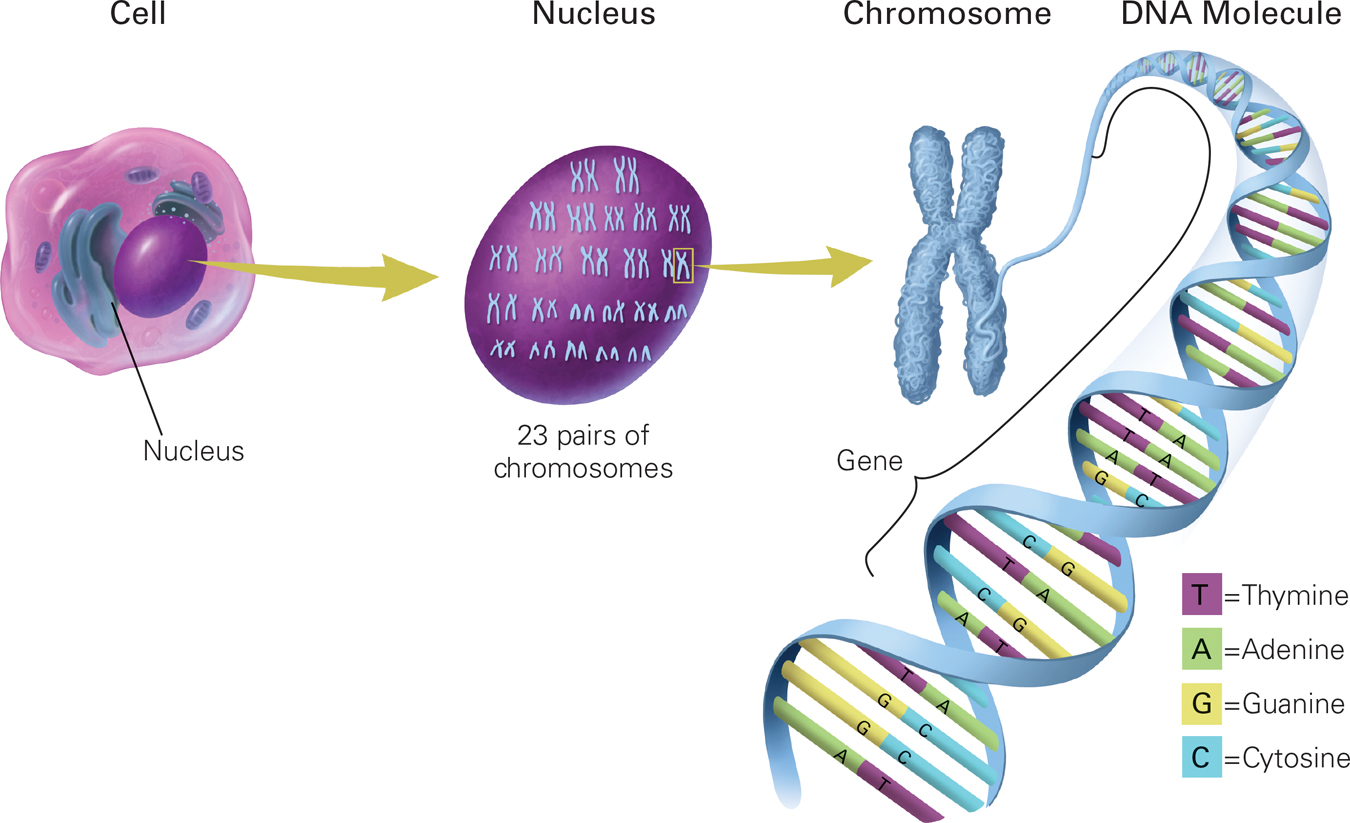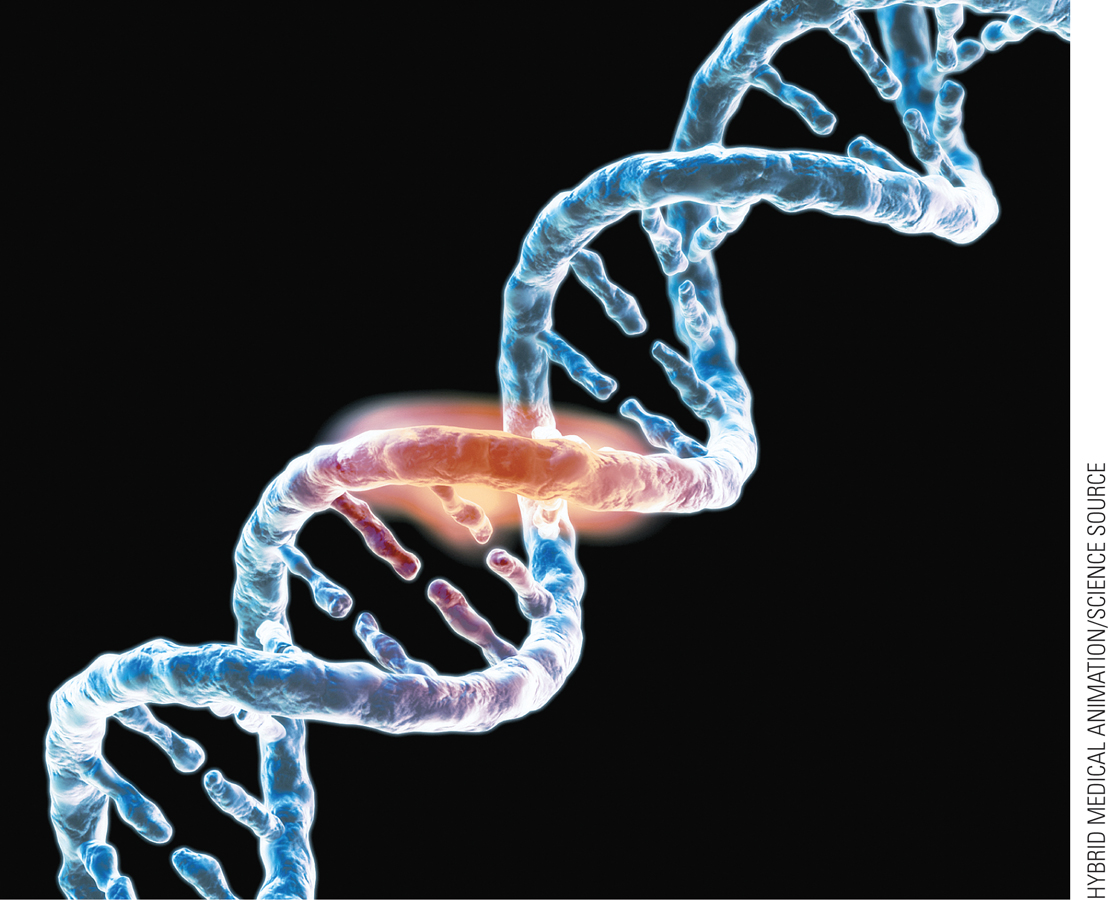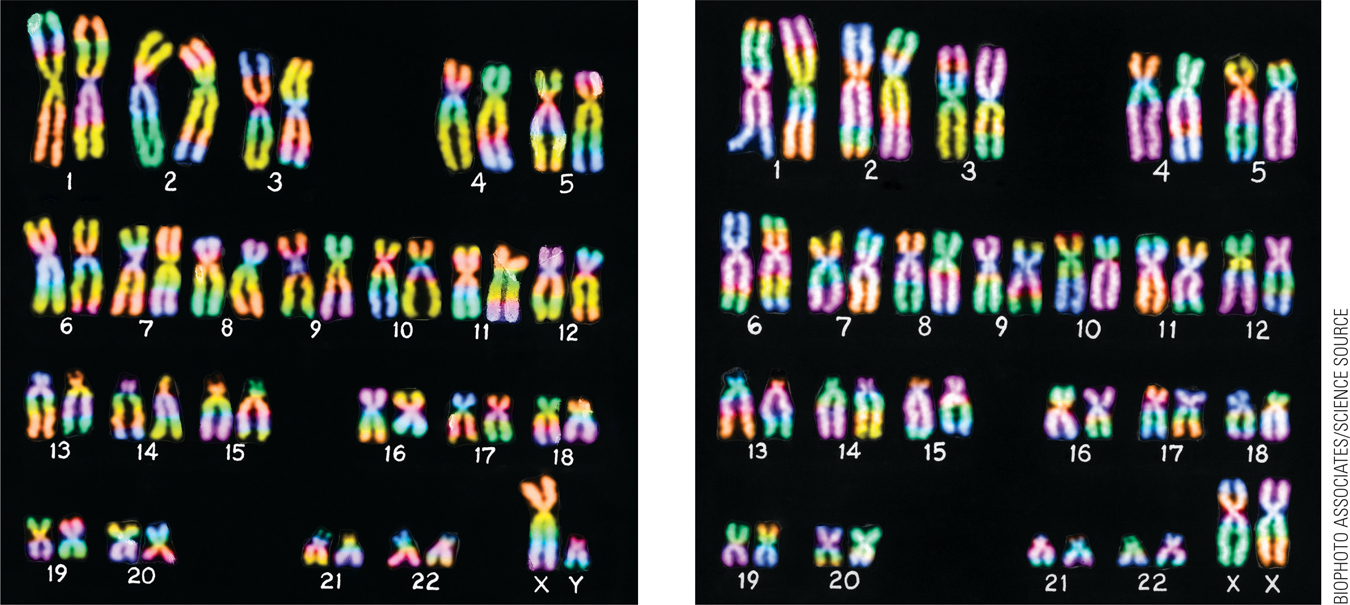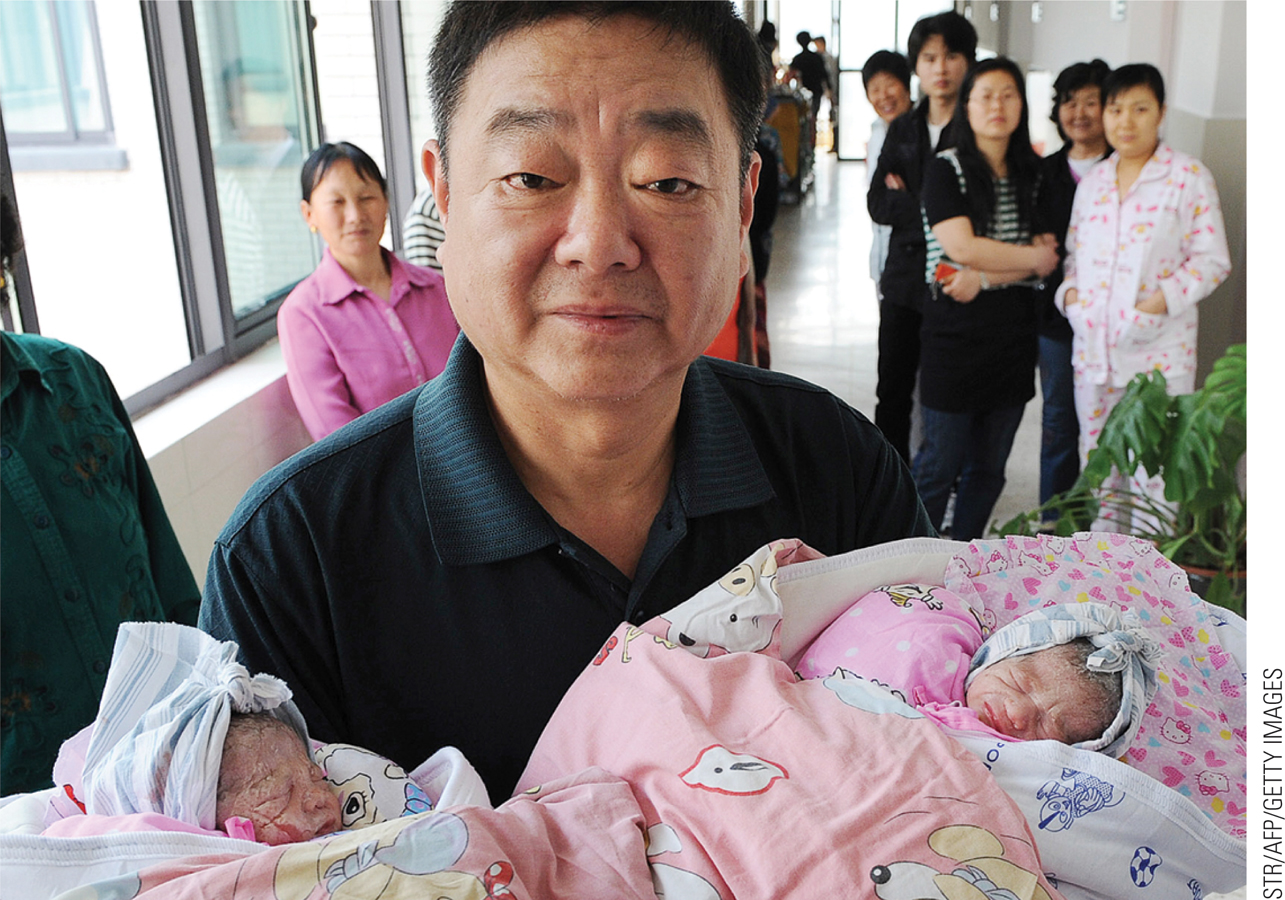The Genetic Code
A reproductive cell is called a gamete. Every person begins life as a single cell, called a zygote the zygote is the combination of two gametes, one sperm and one ovum. The zygote contains all a person’s genes, which affect every aspect of development lifelong. Many people have misconceptions about heredity, so the beginning of this chapter is crucial to understanding human development.
What Genes Are
First, we review some biology. All living things are composed of cells. The work of cells is done by proteins. Each cell manufactures certain proteins according to a code of instructions stored by molecules of deoxyribonucleic acid (DNA) at the heart of the cell. These coding DNA molecules are on a chromosome.
Humans have 23 pairs of chromosomes (46 in all), which contain the instructions to make all the proteins that a person needs for life and growth (see Figure 3.1). The instructions in the 46 chromosomes are organized into genes, with each gene usually at a precise location on a particular chromosome. Humans have about 20,000 genes, each directing the formation of specific proteins, which are made from a string of 20 amino acids.

How Proteins Are Made The genes on the chromosomes in the nucleus of each cell instruct the cell to manufacture the proteins needed to sustain life and development. The code for a protein is the particular combination of four bases, T-
Especially for Scientists A hundred years ago, it was believed that humans had 48 chromosomes, not 46; 20 years ago, it was thought that humans had 100,000 genes, not 20,000 or so. Why?
There was some scientific evidence for the wrong numbers (e.g., chimpanzees have 48 chromosomes), but the reality is that humans tend to overestimate many things, from the number of genes to their grade on the next test. Scientists are very human: They tend to overestimate until the data prove them wrong.
The instructions for making those amino acids are located on about 3 billion pairs of chemicals, called base pairs, arranged in precise order. A small variation—
RNA (ribonucleic acid, another molecule) and additional DNA surround each gene. In a process called methylation, this additional material enhances, transcribes, connects, empowers, silences, and alters genetic instructions. This noncoding material used to be called junk—but no longer. The influences of this surrounding material “alter not the gene itself, but rather the regulatory elements that control the process of gene expression” (Furey & Sethupathy, 2013, p. 705). Methylation continues throughout life, from conception until death.
Obviously, genes are crucial, but even more crucial is whether or not a gene is expressed. The RNA regulates and transcribes genetic instructions, turning some genes and alleles on or off. In other words, a person can have the genetic tendency for a particular trait, disease, or behavior, but that tendency might never appear in that person’s life because it was never turned on. Think of a light switch: A lamp might have a new bulb and an electricity source, but the room stays dark unless the switch is flipped.
Some genetic activation occurs because of prenatal RNA, but some occurs because of later factors, biological (such as pollution) and psychological (as with social rejection). The study of exactly how genes change in form and expression is called epigenetics, with epi a Greek root meaning “around, above, below.”
Researchers who sought a single gene for, say, schizophrenia, or homosexuality, or even something quite specific such as memory for math formulas, have been disappointed: No such genes exist. Instead, almost every trait arises from a combination of genes, each with a small potential impact. Then epigenetics is crucial: Events and circumstances surrounding the genes determine whether or not genes are expressed or stay silent (Ayyanathan, 2014).
Variations
It is human nature for people to notice differences more than commonalities. All people are the same in many ways, not only with two eyes, hands, and feet, but also with the ability to communicate in language, the capacity to love and hate, and the wish for a meaningful life.
Alternate Forms
Nonetheless, each of us is distinct in small ways, not only because of our experiences but also because of our genes. Many scientists seek genetic causes for dissimilarities. Differences begin with alleles, some of which reflect transpositions, deletions, or repetitions of those 3 billion base pairs. Some genes are polymorphic (literally, “many forms”) or, more formally, single-
Polymorphic genes can have two, three, or more versions. Most alleles seem inconsequential; some cause minor differences, such as the shape of an eyebrow or the shade of skin; a few rare ones are devastating. Several destructive alleles in combination with specific epigenetic conditions make a person develop schizophrenia, or diabetes, or some other serious problem (Plomin et al., 2013).
Two Parents, Millions of Gametes

Some variation springs from the simple fact that it takes two people to make one new person. Each parent contributes half the genetic material. Thus the 23 chromosomes from one parent, with their thousands of genes, match up with the 23 from the other, forming identical or nearly identical pairs. Chromosome 1 from the sperm matches with chromosome 1 from the ovum, chromosome 2 with chromosome 2, and so on through the 22nd pair.
On those chromosomes, each gene from one parent connects with its counterpart from the other parent, and the interaction between the two determines the inherited traits of the future person. Since some alleles from the father differ from the alleles from the mother, their combination produces a zygote unlike either parent. Thus each new person is a product of two parents but unlike either one.
Diversity at conception is increased by another fact: When a man or woman makes sperm or ova, and then their chromosomes pair up when they join, some genetic material is transferred from one chromosome to the other, a phenomena called jumping. As a result, “even if two siblings get the same chromosome from their mother, their chromosomes aren’t identical” (Zimmer, 2009, p. 1254).
All these kinds of genetic diversity help societies, because creativity, prosperity, and even species survival is enhanced when one person is unlike another, although there are benefits when genes are shared as well. There is an optimal level of diversity and similarity: Human societies are close to that level (Ashraf & Galor, 2013).
The entire packet of instructions to make a living organism is called the genome. There is a genome for every species and variety of plant and animal—
The particular member of each chromosome pair from each parent on a given gamete is randomly selected. A man or woman can produce 223 different gametes—
Matching Genes and Chromosomes
The genes on the chromosomes constitute the organism’s genetic inheritance, or genotype, which endures throughout life. Growth requires duplication of the code of the original cell again and again.
Matching Autosomes
In 22 of the 23 pairs of chromosomes, both members of the pair are closely matched. As already explained, some of the specific genes have alternate alleles, but at least each of these 44 chromosomes finds its comparable chromosome, making a pair. Those 44 chromosomes are called autosomes, which means that they are independent (auto means “self”) of the sex chromosomes (the 23rd pair).
Each autosome, from number 1 to number 22, contains hundreds of genes in the same positions and sequence. If the code of the gene from one parent is exactly like the code on the same gene from the other parent, the gene pair is homozygous (literally, “same-
However, the match is not always letter perfect because the mother might have a different allele of a particular gene than the father has. If a gene’s code differs from that of its counterpart, the two genes still pair up, but the zygote (and, later, the person) is heterozygous. This can occur with any of the gene pairs, on any of the autosomes. Which particular homozygous or heterozygous genes my brother and I inherited from our parents was purely a matter of chance, and had no connection to the fact that I am a younger sister, not an older brother.
Sex Chromosomes

However, for the 23rd pair of chromosomes, my sex reveals a marked difference between my brother and me. My 23rd pair matched, but his did not. In that he was like all males: When gametes combine to form the zygote, half of the time a dramatic mismatch occurs. In males, the 23rd pair has one X-
Because a female’s 23rd pair is XX, all of a mother’s ova contain either one X or the other—
In some other species, sex is not determined at conception. In certain reptiles, for instance, temperature during incubation of the fertilized egg affects the sex of the embryo (Hare & Cree, 2010). However, for humans, the zygote is either XX or XY, a fact that in the past was not revealed to anyone until the baby was born. Pregnant women ate special foods, slept in a particular way, or repeated certain prayers, all in a vain attempt to control the sex of their fetus—

Determining a Zygote’s Sex Any given couple can produce four possible combinations of sex chromosomes; two lead to female children and two to male. In terms of the future person’s sex, it does not matter which of the mother’s Xs the zygote inherited. All that matters is whether the father’s Y sperm or X sperm fertilized the ovum. However, for X-
Today, sex can be known much earlier: Parents choose names, decorate nurseries, and bond with the future boy or girl—
SUMMING UP The normal human genome contains approximately 20,000 genes on exactly 46 chromosomes, using an estimated 3 billion base pairs of code to make a person. Some genes, called alleles, are polymorphic. Because of small differences in their genetic codes, those alleles make each person unlike any other. The result is that each person is unique yet similar to all other humans. The entire instruction code is the genome, contained in a single cell called the zygote. Each person’s genetic code (their genotype) is expressed because of many environmental influences, an interaction called epigenetics, which produces the phenotype. This is true even for one’s sex, which is determined by a pair of chromosomes, but maleness and femaleness are expressed in many ways.
WHAT HAVE YOU LEARNED?
Question 3.1
How many pairs of chromosomes and how many genes does a person usually have?
A person has 23 pairs of chromosomes and about 20,000 genes.Question 3.2
What causes the similarities of all humans?
Every person begins life with a single called a zygote. In addition, humans have 23 pairs of chromosomes, which contain the instructions to make all the proteins that a person needs for life and growth. All people are the same in many ways, not only with two eyes, hands, and feet, but also with the ability to communicate in language, the capacity to love and hate, and the wish for a meaningful life.Question 3.3
Why do two sisters or two brothers in the same family differ genetically?
Diversity at conception is increased by the following: When a man or woman makes sperm or ova and then their chromosomes pair up when they join, some genetic material is transferred from one chromosome to the other, a phenomena called jumping. As a result, even if two siblings get the same chromosome from their mother, their chromosomes aren' t identical.Question 3.4
Which is more important for a person’s daily life, the phenotype or genotype, and why?
The genotype consists of all of the genes of the developing person. The phenotype represents the person's appearance, behavior, and brain and body functions. Both are important, although the phenotype may be more critical for one's daily life: The genotype instigates body and brain formation, but the phenotype depends on many genes and on the environment. The phenotype is influenced from the moment of conception until the moment of death, sometimes directly ( epigenetic) and sometime via cultural and familial circumstances.Question 3.5
What determines whether a baby will be a boy or a girl?
The 23rd pair of chromosomes determines sex. A 23rd chromosome pair that consists of an X–shaped chromosome from the mother and a Y– shaped chromosome from the father will become a male. A 23rd chromosome pair that consists of two X– shaped chromosomes, each one from the mother and the father, will become a female.
opposing perspectives
Too Many Boys?

Parents can choose the sex of their newborn. Millions of couples have done this. Is this a problem?
The birth of a child of unwanted sex can be prevented long before birth in three ways: (1) by inactivating X or Y sperm before conception, (2) by inserting only the male or female zygotes after in vitro conception, or (3) by aborting XX or XY fetuses. Should all or some of these three methods be banned? In at least 36 nations, prenatal sex selection is illegal, but not in the United States (Murray, 2014).
One nation that forbids prenatal sex selection is China. This was not always so. In about 1979, China began a “one-
In 1993, the Chinese government forbade prenatal testing for sex selection. Many couples broke the law. In 2013, China rescinded the one-

Indeed, sex preferences are apparent in every nation. One elderly Indian man said, “We should have at least four children per family, three of them boys” (quoted in Khanna, 2010, p. 66). Couples of Asian ancestry in the United States also have a disproportionate number of boys (Puri et al., 2011). In some Western nations, including Germany, girls are preferred—
The argument in favor of sex selection is freedom to choose. Some fertility doctors in the United States believe that reproductive rights include that each couple be able to decide how many children to have, and what sex they should be (Murray, 2014). Some people who themselves would not abort a fetus nonetheless favor personal freedom—
Why would anyone object to freedom? The Chinese experience shows that sex selection can have unanticipated consequences. For instance, now many more young Chinese men than women die prematurely. The developmental explanation is that unmarried young men in every culture take risks to attract women and become depressed if they remain single when they want marriage and fatherhood.
Other problems may occur. Males are more likely to be learning disabled, drug addicted, and criminal; they’re also more likely to start wars, commit suicide, and suffer heart attacks. Any nation with more men than women may experience increases in all these problems.
But wait: Chromosomes and genes do not determine behavior. Every sex difference is a product of culture. Even traits that originate with biology, such as the propensity to heart attacks, are affected more by environment (in this case, diet and cigarettes) than by XX or XY chromosomes. Perhaps nurture could change if nature produced more males than females, and then societies would not suffer. The frequency of sex selection is influenced by national policy and cultural values (Parker, 2012).
Might laws against prenatal sex choices be unnecessary if culture could shift? “Might” … “if” … Critical thinking needed.